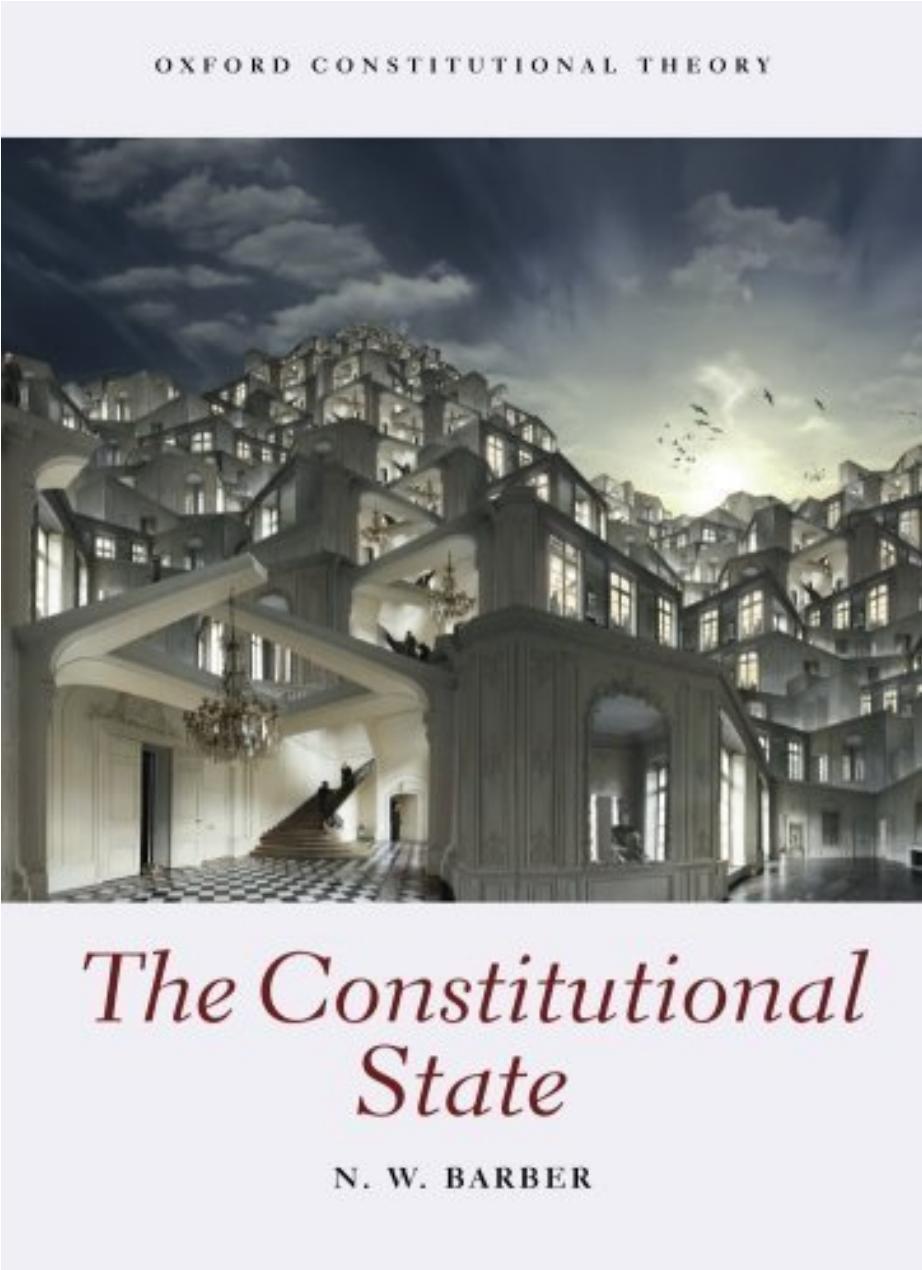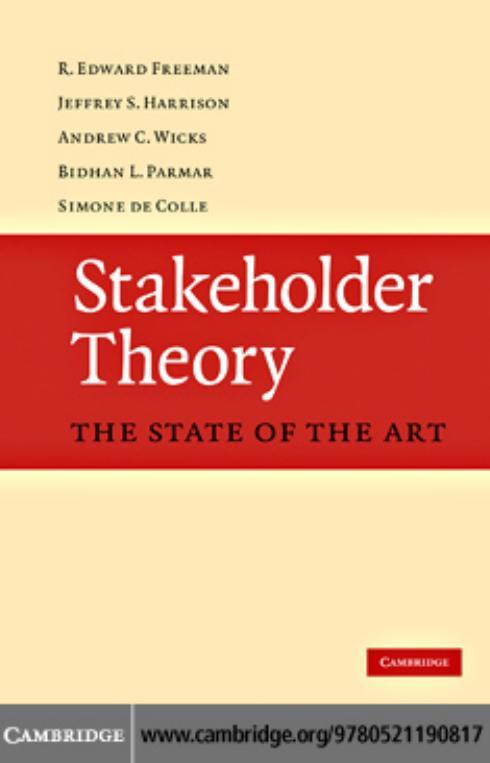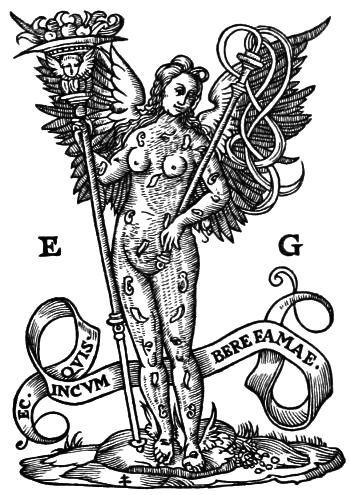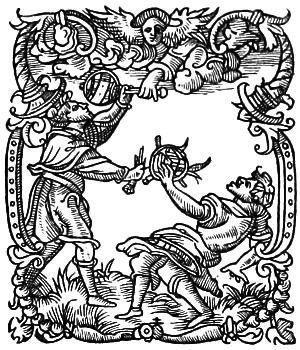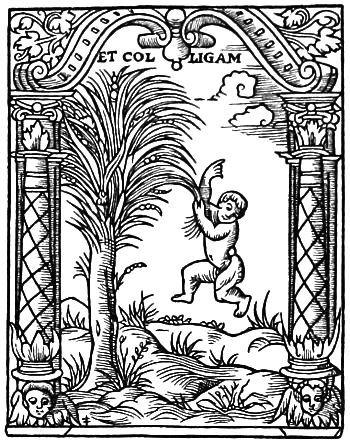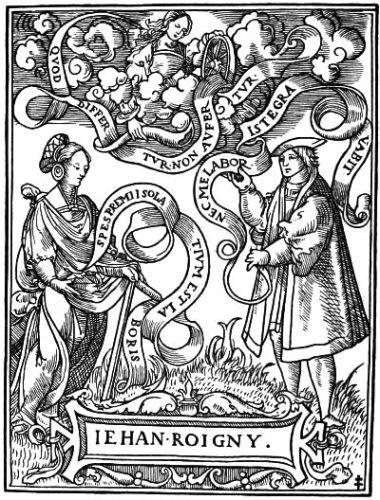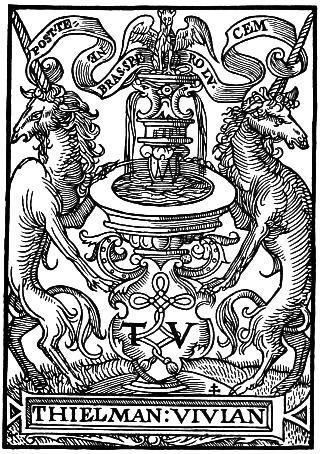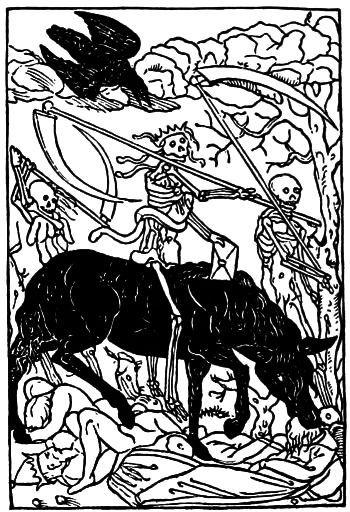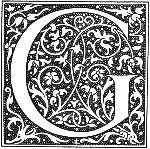Random
documents with unrelated content Scribd suggests to you:
latin' (quarto), published by Charles in 1559. It is probable that the second Robert used these same marks after his uncle's retirement in 1561.
FEZANDAT (MICHEL), printer-bookseller at Paris from 1541 to 1553. One mark (Silvestre, no. 423). This mark which, by way of allusion to the name of its owner, represents a pheasant (faisan) on a dolphin, with the letters M and F at the left and right, respectively, of the pheasant, was used without the initials in 1549, as may be seen on the title of 'Le Temple du chasteté,' printed in that year by Fezandat, in octavo.[462]
In 1550, one Guillaume Alard (Fezandat's son-in-law, it may be), who lived 'e regione collegii de la Mercy,' also used the mark in that form.[463] The appearance of this mark on Alard's book may be due solely to the fact that the book in question was printed by Fezandat. I have been unable to ascertain the facts because the fragment of the title-page on which I saw the mark and Alard's name does not contain the title of the book. The only possible clue is the three Greek verses on the other side of the page, which lead one to think that it may have been a work of Jean Blaccus Danois, of whom we have a translation of Isocrates into Latin verses, printed by Regnault Chaudière, also in 1550 (quarto).[464] This G. Alard is not named by Lottin in his 'Catalogue des imprimeurs-libraires de Paris.' I find the same mark in a small volume entitled 'Le Bouquet des fleurs de Sénèque'; octavo; Caen, 'de l'imprimerie de Jacques le Bas, imprimeur du roy,' 1590.[465] I find Fezandat's mark also in a book published by the bookseller J. Dupuy in 1549: 'Novum Testamentum,' in Greek and Latin; 16mo. Why? I have no idea.

GIBIER (ELOI), printer at Orléans. One mark, representing a printingpress. This printer, whose oldest known imprint is dated 1559, had evidently practised his trade several years earlier. This is what we find concerning him in the 'Bibliothèque historique des auteurs orléanais,' by Dom Gerou, which is preserved in manuscript in the Public Library of Orléans: 'We may say that Eloy Gibier was in a certain sense the first printer of Orléans; Mathieu Vivian and Pierre Asselin had preceded him, but we know of only a single work printed by each of them, whereas there are a great number by Eloy Gibier. We do not know when he began, but the earliest book printed by him of which we have any knowledge is of 1559. At first he put no symbol on the title-pages of his works; the place where the symbol should be was entirely unoccupied; later, he sometimes inserted one, but not always. This symbol was a printing-press, about which were
the words: "In sudore vultus tui vesceris pane tuo."' I have seen this mark on the 'Coutumes générales d'Orléans,' printed by Gibier in 1570, octavo.[466] But he afterward adopted the mark of Conrad Bade. See that name.
GOURMONT (GILLES DE), printer-bookseller at Paris, from 1506 to 1530. Three marks. The first, in the form of a border, is found on the title-page of a volume containing nine comedies of Aristophanes, printed by Pierre Vidoue, at Gilles de Gourmont's expense, in 1528 (quarto)[467]: a description of it will be found above.[468] The second represents Fame: it is a nude woman, winged, all over whose body are eyes, tongues, and ears. At the foot, in a scroll, are the words: 'Ecqvis incvmbere famae' ('poterit' understood, no doubt).
The Lorraine cross appears at the left on the lower edge of the engraving. I have seen this mark on a small book entitled: 'Alphabetum hebraicum,' consisting of 8 leaves, printed by Pierre Vidoue (Silvestre, no. 98). Although the name of Gourmont nowhere appears in this case, I have no doubt that the mark belongs to Gilles de Gourmont, for it is accompanied by his initials, E and G (Egidius Gourmontius), at the left and right respectively; and we shall see that this same mark was afterward used by Jérôme de Gourmont, Gilles's son or nephew. It maybe that it was because of the loan of Gourmont's Hebrew type that his mark appears on this precious pamphlet, a description of which follows. First leaf, beginning at the end (according to the Hebrew and Arabic custom), Gourmont's mark in a border of detached compartments. On the verso Pierre Vidoue's epistle to the reader, dated from his workshop August 1, 1531. Then comes the text, followed by this subscript: 'Petrus Vidovæus Vernoliensis excudebat Lutetiæ' And, lastly, Vidoue's mark—Fortune, with the words: 'Audentes juvo' (Silvestre, no. 65). The third of Gilles de Gourmont's marks signed with the Lorraine cross is given by M. Silvestre (no. 826). [This mark forms the lower part of the border first described, and has evidently been cut from the border for use separately.] It represents the Gourmont arms[469]: a shield coupé, three roses in chief and a crescent in base; for crest a St. Michael, holding a bare sword, supports two winged stags with ducal coronets about their necks. This subject, much more fully developed, appears on the first page of the 'Tableaux des Arts Libéraux de Savigny,' in-plano,[470] published in 1587, by Jean and François, sons of Gilles de Gourmont, who succeeded to his establishment on rue Saint-Jean-de-Latran.
GOURMONT (JÉRÔME DE), printer-bookseller at Paris from 1524 to 1533. —One mark representing Fame, copied from the second mark of Gilles de Gourmont just described, but reversed. Beneath the inscription 'Ecqvis incvmbere famae,' in a small cartouche, are the initials H. D. G. (Hierome de Gourmont), with the Lorraine cross just
above. I have seen this mark in an octavo volume published at Paris in 1534 by Jérôme de Gourmont, under this title: 'Pauli Paradisi ... de modo legendi hebraice dialogus,'[471] and in another octavo, also published at Paris ('Dionysiæ') in 1535, under a Greek title of which the Latin translation is: 'Apollonius Alexandrinus, de Constructione.'[472] Jérôme de Gourmont published at least one other book at 'Dionysiæ' in 1535; but I do not know the title, as I have not seen the title-page. All that I can say is that Ausonius is quoted in the Latin preface printed on the verso of the first leaf, of which I have seen only a fragment, belonging to M. Silvestre.
I believe that Jérôme de Gourmont did some printing, although he is named only as a bookseller in the bibliographies. The books that I have mentioned show that he was a scholar who followed in the tracks of Gilles de Gourmont. Indeed, the one first described, which is in Latin, contains some Hebrew words; the second is entirely in Greek.
I have seen a little book, printed at Paris in 1539, with Jérôme de Gourmont's mark: it is 'Pugna porcorum per J. Porcium,' octavo. The subscript below the mark reads: 'Parisiis, apud Anthonium Bonnemere.' Was Anthoine Bonnemere publisher for Jérôme de Gourmont, at the same sign? That is something that I do not know.
GOURMONT (BENOÎT DE), bookseller at Paris.—One mark, representing a man standing above two precipices; above him is a scroll with the words: 'Vndiqve praecipitivm'; and at his feet the initials B. D. G. (Silvestre, no. 838).
GRANDIN (LOUIS), printer-bookseller at Paris, from 1542 to 1553.—Two marks (Silvestre, nos. 277 and 416). They represent two men, one of whom is receiving a sphere from the hand of God; the other holds one which is crumbling in his fingers. On the second of the two marks are the words: 'Confidere in Domino bonum esse quam confidere in homine. Ps. 117.'
GUEULLARD (JEAN), printer-bookseller at Paris, from 1552 to 1553.— Two marks representing the Phœnix rising from the flames,[473] in an oval border. The smaller one has, within the border, the words, 'Amor vitæ acer nimis,' with Gueullard's initials, I. G., below (Silvestre, no. 790). This mark is .055 of a millimetre high by .044 wide. I have seen it in a book entitled: 'Petri Ruffi Druydæ dialectica, nuper ab eodem autore emendatur,' quarto, 1553 (3d edition).[474] The larger one has this motto within the border: 'Mori vivere mihi est'; it is .087 of a millimetre high by .063 wide (Silvestre, no. 882).
I have seen it in a book entitled, 'Hexastichorum moralium libri duo, per Nic. Querculum Tortronensem Rhemum; quarto, Paris, 1552.'[475] See HARSY (OLIVIER DE).
GUILLARD (CHARLOTTE), printer-bookseller from 1518 to 1556.—One mark representing her sign, a golden sun in a starry sky. Below, two lions erect, holding a shield on which are the initials C. G. This lady carried on the printing trade for more than fifty years. She married first, in 1502, Berthold Rembold, a partner of the first printer in
Paris, Ulric Gering. Berthold, who had established his domicile on rue Saint-Jacques, 'au Soleil d'Or,' having left Charlotte a widow in 1518, she carried on the business alone until 1520, when she married Claude Chevallon, who took up his abode on the same premises. Chevallon having departed this life, in his turn, in 1542, Charlotte continued in the business until 1556. It was during her second widowhood that the mark in question, which we reproduce herewith, was engraved. I have seen it on a quarto volume entitled, 'Institutionum civilium libri quatuor, 1550. Parisiis, apud Carolam Guillard, viduam Claudi Chevallonii, sub Soli aureo, et Guilelmum Desbois, sub Cruce Alba, in via divi Jacobi.' Claude Chevallon had upon his mark, by way of allusion to his name, two horses standing (cheval-long). But M. Silvestre publishes as his (no. 395) a mark which has the lions.
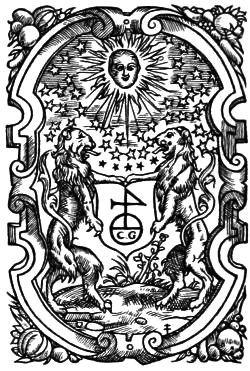
HARSY (OLIVIER DE), bookseller at Paris, from 1556 to 1584, used Gueullard's mark on several works written by Nicolas Ellain; among others, 'Elegia libri duo ad Joach. Bellaium, quo adhuc vivo eos scripsit.—Parisiis, e typogr. Olivarii de Harsy, ad Cornu cervi, in
clauso Brunello'; quarto, 1560.[476] I have no idea why de Harsy adopted Gueullard's mark.
HOTOT (FABIAN), printer at Orléans. See BADE (CONRAD).
HOUIC (ANTOINE), bookseller at Paris. See REGNAULT (BARBE).
KERVER (THIELMAN II), printer and bookseller at Paris, from 1530 to 1550.—One mark, representing the arms of the Kervers; a 'gril' (cratis) held by two unicorns, with the letters T. K. Below is the printer's name in full: 'Thieman [sic] Kerver.' This mark appears on a book of Hours of 1550.
LE BLAS. See FEZANDAT.
LE COQ (JEAN) printer at Troyes, from 1506 to 1525.—One mark, representing Le Coq's arms (a cock), hanging from a tree; below is the name, 'Jean Le Coq' (Silvestre, no. 875). This mark appears in a 'Graduel' of 1521, previously described.[477] We find it again in a book of Hours according to the use of Toul, published in 1541, which contains many other engravings signed with the double cross.[478] Also in a small book published in our own day by Aubry the bookseller[479]; that is to say, this particular woodcut is still in existence and belongs to M. Aubry.
LE NOIR (PHILIPPE), printer-bookseller at Paris, from 1520 to 1539. Three marks,[480] representing two negroes (noirs) holding a shield with Philippe le Noir's initials.
MALLARD (OLIVIER), printer-bookseller at Paris, from 1536 to 1542.
MALLARD (JEAN), bookseller at Rouen.
MARNEF, DE: Enguilbert, Jean and Geoffroy, brothers, were printers and booksellers at Paris and Poitiers, together or separately, from 1510 to 1550. Their mark was a pelican, piercing his side in order to nourish his young. Tory engraved for them at least two marks: one which appears on a book printed by Enguilbert and Jean, in Poitiers, in 1536,[481] entitled 'Les angoisses et remedes d'amour du Traverseur en son adolescence' (by Jean Bouchet), with this device: 'Eximii amoris typus'; it is reproduced by Dibdin,[482] and by Silvestre (no. 152).[483] The other may be seen in the Print Section of the Bibliothèque Nationale, among Tory's work; the pelican and its young are in an oval border, around which is this device: 'Principium ex fide, finis in charitate' (Silvestre, no. 1044). [See also the reproduction at the beginning of this section, page 265.]
MENIER (MAURICE), printer at Paris, from 1545 to 1566.—One mark (Silvestre, no. 789), representing a man closing a woman's mouth, with this device, 'Coercenda volvptas.'
MERLIN (GUILLAUME), bookseller at Paris, from 1538 to 1570.—One mark, representing a swan whose neck is twined about a cross, surrounded by the device, 'In hoc signo vinces.' The Lorraine cross is barely visible in the lowest ornament of the engraving. I have seen this mark on the first page of a 'Missale ecclesie Parisiensis,' in folio, without date, printed by Iolande Bonhomme, widow of the first Thielman Kerver, as is shown by the presence of that printer's mark on the first page of the text; it may be that there are copies in her name. This book is without date, but should be placed between the years 1532 and 1552, which embrace the incumbency of Jean du
Bellay as Archbishop of Paris. Merlin's mark is .095 of a millimetre high by .067 wide.[484]
MOREL (GUILLAUME), printer-bookseller at Paris, from 1548 to 1564.— One mark, reproduced by M. Silvestre (no. 164), who informs me that his engraver accidentally omitted the Lorraine cross. 'This mark,' he adds, 'was used later by Estienne Prevosteau, Morel's son-in-law, who subsequently reëngraved it, or had it reëngraved, with his initials, E. P. in place of Tory's mark.'[485] It represents a capital theta (Θ), about which are twined two winged serpents, and in the centre an angel, seated on the cross-piece of the Θ, with a lighted torch in her hand.
NIVELLE (SEBASTIEN), printer and bookseller, at Paris, from 1550 to 1601. One mark, representing two storks in the air, one being carried and fed by the other; with this verse from Exodus (XX, 12), to explain the drawing: 'Honora patrem tuum et matrem tuam, et sis longævus super terram.' I have seen this mark on an octavo edition of St. John Chrysostom ('Homeliæ duæ'), printed by Sebastien Nivelle in 1554. It is reproduced by M. Silvestre (no. 201), but the Lorraine cross is barely visible on this impression. I have seen also another mark of Nivelle's representing the same subject, with analogous designs suggesting filial love in the four corners; but it is not signed with the cross although it is absolutely in Tory's manner.
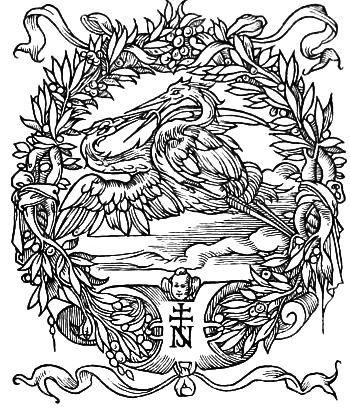
NYVERD (GUILLAUME), printer and bookseller at Paris, from 1516.—One mark, or, to speak more precisely, a small border in the style of one of the marks of Simon de Colines. At the foot, in a scroll, are the words, 'Nasci, laborare, mori.' This border appears in a small pamphlet, undated, in pure gothic type, entitled, 'La Reformation des tavernes et destruction de gourmandise, en forme de dialogue'; a small octavo of 4 leaves, of which M. Cigogne possesses the only known copy (1856). At the end are the words, 'Paris, by Guillaume Nyverd, printer.' So that Lottin is mistaken in saying that he was a bookseller only. He gives only one date for his career in the trade— 1516—but our engraving is certainly later than 1520. M. Silvestre extends Nyverd's business career to 1559, on what grounds I do not know; but he also calls him a bookseller only. The text of the 'Reformation des tavernes,' etc., was reprinted on page 223 of the second volume of the 'Recueil des poésies françoises des XV et XVI siècles,' collected and annotated by M. Anatole de Montaiglon.[486]
NYVERD (GUILLAUME DE), probably the son of the preceding, printerbookseller at Paris, from 1550 to 1580.—One mark, representing the arms of France borne by two winged genii. Above them a head with wings; from its mouth come two garlands in the style of those on the last plate of 'Champ fleury.' At the left, at the foot of the cut, the letters G. N., and at the right the Lorraine cross. This engraving, which is 8 centimetres wide by 11 high, was undoubtedly executed when Guillaume de Nyverd was appointed king's printer, which title he held in 1561, according to Lottin. In all probability he held it earlier than that. However that may be, I have seen this mark, already much worn, in an impression of 1572: 'Prognostication touchant le mariage du tres honoré et tres aimé Henry, par la grace de Dieu roy de Navarre, et de tres illustre princesse Marguerite de France, calculée par maistre Bernard Abbatia, docteur medecin et astrologue du tres chrestien roy de France' [Charles IX]. There are in the Bibliothèque Nationale at least three editions of the little pamphlet, made by the same printer at about the same time, that is to say immediately after the marriage of the King of Navarre with Marguerite de Valois. All three have this engraving on the last page, but in every case it is accompanied by an addition of much later date, namely, the device of Charles IX (two pillars joined by a scroll containing the words, 'Pietate et Jvsticia'), above the arms of France. The volume contains also numerous other engravings and letters bearing Guillaume de Nyverd's initials. It is worth while to call attention to the fact that de Nyverd does not assume the title of king's printer in this book, although, as we have seen above, his appointment was of much earlier date.
PALLIER (JEAN), called 'Marchand,' printer and bookseller at Metz, from 1539 to 1548.—One mark (Silvestre, no. 156), representing a fleurde-lis held in the air by two naked children, with the letters I. P. in the field.[487] Jean Pallier, or, better, Palyer (in Latin, Palierus), did business also in Paris, for I have seen several books of his dated
from that city in 1541 or 1542, with the mark described above. I will mention, among others: (1) 'Epitomæ singularum distinctionum libri primi sententiarum, cum versibus memorialibus Arnoldi Vesaliensis,' etc., 16mo, Paris, 1541; and (2) 'Topica Marci Tullii Ciceronis,' etc., 'ex officina Joannis Palierii, e regione Navarræ, sub signo Leonis Coronati,' 4to, 1542.
PARIS (NICOLE), printer at Troyes, from 1542 to 1547.—One mark (Silvestre, no. 175), representing a child clinging to the branches of a palm-tree (?), beneath the device, 'Et Colligam.'
PERIER (CHARLES), bookseller at Paris, from 1550 to 1557.—One mark, found on the title of the folio entitled, 'Les quatre livres d'Albert Durer ... de la proportion des parties et pourtraicts des corps humains, traduits par Louys Meigret,' etc., 'chez Charles Perier ... à
l'enseigne du Bellerophon, 1557.'[488] This bookseller issued two editions of Dürer's book in the same year, one in Latin and the other in French, both illustrated with the same cuts. I am unable to say which appeared first. He had already published, in 1555, for Louis Meigret, a translation of 'Les XII livres de Robert Valturin, touchans la discipline militaire,' in folio, with engravings, in which his mark appears, signed with the double cross. The sign of Bellerophon was retained by Charles Perier's son Thomas.
PETIT (OUDIN), bookseller at Paris from 1541.—One mark (Silvestre, no. 103), representing a shield bearing a fleur-de-lis, and held by two lions; in the field the letters O. P.
PORTE (MAURICE DE LA), bookseller at Paris from 1524 to 1548.—One mark used by his widow in the volume entitled, 'M. A. Mureti Juvenilia'; octavo, 1553.[489] Maurice de la Porte's widow sold his plant to Gabriel Buon, who used the marks of the deceased from 1558 to 1587. They represent a man carrying a valise at the door (à la porte) of a house; one of them has the device, 'Omnia mea mecum porto.' The man is Bias,[490] according to La Caille. About the same time there was a printer at Lyon named Hugues de la Porte, whose mark represented Samson carrying away the gates (portes) of Gaza in his arms, with the device, 'Libertatem meam mecum porto.' (He also published a folio Latin Bible in 1542.)[491]
PREVOSTEAU (ESTIENNE). See MOREL (GUILLAUME).
REGNAULT (BARBE), bookseller at Paris from 1556 to about 1560.—One mark, representing an elephant carrying a tower on his back, with the device, 'Sicut elephas sto'; height 7½ centimetres, width 5½ centimetres. Barbe was undoubtedly the daughter of François
Regnault, who died in 1552, and who had a similar mark.[492] François Regnault's mark was retained by his widow, Madeleine Boursette, who added to it her initials, M. B., and did business in her own name until 1555. Barbe Regnault's mark first appears, so far as my knowledge goes, in a small octavo, printed about 1556, entitled, 'Description de la prinse de Calais et de Guynes, composée par forme de style de proces par M. G. de M.' (Here the mark.) 'A Paris, chez Barbe Regnault, rue Sainct-Jacques, à l'enseigne de l'Elephant.'[493] La Caille informs us of other works published about the same time by Barbe Regnault: 'Monstre d'abus contre Michel Nostradamus,' 1558; J. Seve, 'Supplication aux rois,' ... 'de faire la paix entre eux,' 1559. In 1560 she published a book by Estienne Brulefer, in octavo, entitled, 'Identitatum et distinctionum ... traditarum compendiosa contractio'; then comes the mark, and below it an imprint in which Barbe styles herself the widow of André Barthelin.[494] I am unable to say whether this is the same man whom La Caille and Lottin call André Berthelin, and who published in 1544 a work entitled, 'Francisci Georgii Venali ... de Harmonia mundi totius cantica tria'; folio, Paris, 'apud Andream Berthelin, via ad divum Jacobum, in domo Guilelmi Rolandi, sub insigne Aureæ Coronæ, et in vico Longobardorum in domo ejusdem Rolandi.'[495] If he is the same man, we must assume that he was not yet married to Barbe Regnault, for we see that, while he lived, as she did, on rue Saint-Jacques, he had a different sign. Indeed, I am inclined to think that Barbe did not adopt the 'Elephant' until after the death of Madeleine Boursette, François Regnault's widow, about 1556. However that may be, La Caille says that Barbe Regnault's mark passed into the hands of Thibault Bessault, then to his son Jean, and finally to Antoine Houic. I have seen a book published by the lastnamed in 1582, embellished with Barbe Regnault's 'Elephant.'
ROBINOT (GILLES I), bookseller at Paris, from 1554 to 1575.—One mark (Silvestre, no. 686), representing Icarus hurled into the sea for not following the advice of Dædalus, his father, not to approach too
near the sun lest that luminary should melt the wax with which the wings of our presumptuous youth were fastened to his body. In a scroll are these words, 'Ne quid nimis.' This mark was used as late as 1619 by Gilles Robinot the second, son of the first Gilles[496]; it is .05 of a millimetre high by .047 wide. See SERTENAS.
ROFFET (PIERRE), called 'Le Faulchoir,' bookseller at Paris, from 1525 to 1537.—One mark (Silvestre, no. 150) representing a mower (faucheur) appears in a book printed in 1536.[497]
ROIGNY (JEAN DE), bookseller at Paris, from 1529 to 1562. I know two marks of de Roigny, signed with the Lorraine cross. The older is the one that appears in a superb edition of Pliny's 'Letters,' printed by Josse Bade in 1533, in folio (Silvestre, no. 674).[498] It represents a man and a woman, each holding a scroll containing a Latin motto; the man's reads thus: 'Nec me labor iste gravabit'; and the woman's, 'Spes premii solatium est laboris.' In the sky is Fortune with her wheel and the horn of plenty, and this device in a scroll beneath: 'Quod differtur non aufertur.' The second mark, which was adopted
by Jean de Roigny after the death of his father-in-law, Josse Bade, in 1535, is the 'Prelum ascensianum,' but reëngraved (Silvestre, no. 787); for Bade's typographical plant passed into the hands of another son-in-law of his, Michel de Vascosan, who continued to use his father-in-law's old woodcuts, especially his mark, badly worn as it was. As for Robert Estienne, Bade's third son-in-law, his father-inlaw's death caused no change in his typographical arrangements; he still retained the 'Olive-tree' which he has made so celebrated.
SERTENAS (VINCENT), bookseller at Paris, from 1534 to 1561.—One mark, which was used on two opuscula, in octavo, of 1561; they are usually bound in the same volume, and are entitled: (1) 'Régime de vivre et conservation des corps humains,' etc.; (2) 'Recueil de
plusieurs secrets très-utiles pour la santé,' etc. This mark represents the initials V. S. interlaced, in a medallion above which is the sun, with a genie on each side; and below, the device, 'Vincenti non victo.' We also find Robinot's mark, described above, in certain books published by Sertenas. I will mention among others the 'Recueil des rimes et proses, by E. P.; octavo, 1555.[499] Presumably, it was because Robinot was the printer that he placed his mark on the books.
VIVIAN (THIELMAN), bookseller at Paris in 1539.—One mark (Silvestre, no. 725), which appears in the second part of the 'Grand Marial de la mère de vie,'[500] translated by Adam de Saint-Victor. This second part is entitled, 'A la très-pure et immaculée Conception de la Vierge'; quarto, 1539. Vivian lived in Clos Bruneau; his mark bore this device, 'Post tenebras spero lucem' in a scroll, above a fountain guarded by two unicorns; below are the letters T. V., and still lower, 'Thielman Vivian.'
1. OfhisForbearsandCollateralRelations.
ENEALOGICAL investigation, supplemented with information furnished by two learned Berrichons, enabled me to enumerate, in my first work on Tory, a considerable number of members of his family, all, or almost all, of whom lived in Faubourg SaintPrivé [Bourges]. The recent researches of my friend M. Hippolyte Boyer, Deputy Archivist of the Department of the Cher, make it possible for me to make known his grandfather, his father, and all his brothers and sisters.
'By deed of December 29, 1486, Robert Thory, husbandman, living in the parish of Saint-Germain-du-Puy, conveys to Jean Thory, his brother, for 20 livres tournois, his share in the heritage of the late Jean and Jeanne, their father and mother.'
'By contracts of September 5 and 8, 1507, Jean Thory, of Saint-Privé, [501] and Philippe Thoreye, his wife, give their two daughters, Jehanne Thorye and Perron Thorye, in marriage to Thevenin and François Leconte, sons of Jean Leconte.' Among the provisions of Perron's contract is one to the effect that Jean Thory and his wife settle a dowry of 40 livres tournois on their daughter: 'and this in satisfaction of all claim upon father and mother, be it in respect of furniture or of inheritance, which said claim the said future bride, with the authority of her said future husband, hath renounced and doth by these presents renounce, in favour of her father and mother, of maistre Geoffroye, André, Antoine and Michell Thoris, children of said Jean and Philippe, save for the power to,' etc.[502]
Thus it appears that Geofroy was the oldest of the brothers and sisters, as he is named first in the document. Now, as two of his sisters were of marriageable age in 1507, and as he is called maistre, it is probable that he himself was more than twenty-five. That is why I have placed his birth about 1480.
2. OfhisDescendants.
Jean Toubeau, printer and bookseller at Bourges, who died at Paris in 1685, while on a mission for his native place,[503] wrote the following in the preface to his 'Institutes consulaires,' printed by himself in 1682, three years before his death: 'I have not been impelled to undertake and write this work by the examples of the illustrious members of my profession. Nor is it the example of those of my own family who have given their works to the public: Geofroy Tory, professor in the University of Paris, and a printer and bookseller in the same city, who was so prolific that, proposing to put forth a book which should teach the scope and proportions of those beautiful roman letters which we use to-day in printing, he could not forbear to produce a book overflowing with learning, which was followed by numerous others of instruction, which are so well known that it is needless to give a list of them here, especially as M. de la Thaumassière gives them a whole chapter in our history.'
It is evident from this passage that Toubeau was related to Tory, but it is not clear how the relationship came about; and La Thaumassière does not mention Tory in his 'Histoire du Berry,' printed a few years later by François Toubeau, Jean's son, despite the promises which he seems to have made to Jean, who had transferred to him the duty of making known to posterity that illustrious son of his province.
The only author able to assist us at all in our investigations is Moréri, who, in the article on Jean Toubeau in his great historical dictionary, says that he was the great-great-grandson of Tory, on his mother's side. This statement should be exact, and the article appears to be written from information furnished by the Toubeau family; but all that we can determine from it is that Toubeau was a descendant of Tory in the fourth degree. Whether he descended from a son or daughter of Geofroy, I have been unable to discover. To elucidate this fact, I wrote to M. Auguste Toubeau, judge of the civil court at Bourges, and this was his reply, dated March 5, 1856: 'I should have been glad to give you the information you desire about Tory. But I have no documents or family papers which establish his relationship
to Jean and Hilaire Toubeau. I do not know what connection there was between them and Tory, and I learned that there was such a connection only from what Moréri says of it.'
Failing family papers, I made fruitless efforts to fix the relationship between the Toubeaus and Tory. Finding it impossible to reach any certain result, I have abandoned this search, which has no bearing upon the history of our illustrious typographer. The Toubeaus alone are interested in the solution of the question; I leave to them the task of proving their kinship.
POSTSCRIPT.—It may be surmised that Bonaventure Torinus, bookseller of Bourges, who caused to be printed at that city, in 1595, by the widow of Nicolas Levez, the 'Epitome juris civilis,' by an unknown author, and 'Julii Pauli receptarum sententiarum libri V,'[504] was Tory's son, for he wrote his name in Latin in the same way that Tory wrote it; but was it from a daughter of Tory or from a daughter of this Bonaventure that Toubeau descended? It is impossible for me to say. The lateness of the period at which Bonaventure makes his appearance leads me to believe that he did not see the light until Tory had reached an advanced age. Indeed, if we compare the dates, we shall find that this son of Tory cannot have come into the world before 1530, for, starting from that year, he would have been sixty-five years old in 1595, when his 'Epitome juris' was printed, and there is no reason to believe that he died very soon thereafter. For my own part, I believe that he was not born until after the publication of 'Champ fleury,' and that his Christian name was an allusion to his late birth.[505] In that case, we can understand why he did not succeed to the paternal establishment: he was only two or three years old at Geofroy's death—too young to think of taking his place; so that that duty fell to Geofroy's pupils, whoever they may have been. As for Bonaventure, the family traditions naturally led him back to Bourges, and the trade that he adopted brought him still nearer to his father.
VERSES IN HONOUR OF GEOFROY TORY, PRINTED AT THE HEAD OF PALSGRAVE'S GRAMMAR. [506]
'Ejusdem [Leonardi] Coxi ad eruditum virum Gefridum TROY[507] de Burges[508] Gallum, Campi floridi authorem, quem ille sua lingua Champ fleury vocat, nomine omnium Anglorum, phaleutium.
'Campo quod toties, Gefride docte, 'In florente tuo cupisti habemus.
'Nam sub legibus hic bene approbatis
'Sermo gallicus ecce perdocetur.
'Non rem grammaticam Palæmon ante 'Tractarat melius suis latinis,
'Quotquot floruerant ve posterorum,
'Nec Græcis melius putato Gazam 'Instruxisse suos libris politis, 'Seu quotquot prætio prius fuere,
'Quam nunc gallica iste noster tradit.
'Est doctus, facilis, brevisque quantum
'Res permittit, et inde nos ovamus,
'Campo quod toties, Gefride docte, 'In florente tuo cupisti, habentes.'
Remarksontheforegoinglines.
The numerous errors of all sorts which disfigure Palsgrave's book (a very interesting book, none the less)—errors of which the foregoing lines afford several specimens—should have humbled to some extent the national vanity of the author, who cries out incessantly, throughout his bulky volume, against the ignorance of French printers. He should, in any event, have remembered that English typography was the very humble daughter of French typography, which latter not only trained the first English artist (Caxton), but also gave him his two most illustrious successors,—Wynkyn de Worde and Pinson,—the last named of whom did in fact print a part of Palsgrave's book.
A modern Englishman, David Baker, has gone even farther than Palsgrave; he says, speaking of Palsgrave's work: 'the French nation, so proud to-day of the universality of its language, seems to owe it to England.' To which M. Génin retorts: 'Baker reasons backward. The French language did not come into universal use because it pleased Palsgrave to write a grammar; on the contrary, Palsgrave

